Last Updated on October 14, 2024 by Chef Mireille
This post may include affiliate links.
If you’re looking for a delicious comforting dessert that’s both vegan and gluten-free, this Kolak Labu Kuning, also known as sweet pumpkin soup, is a must-try!
Made with tender pumpkin, sweet potatoes, and ripe plantain, this Indonesian dessert is a creamy, sweet dish that’s perfect for satisfying your cravings. The rich coconut milk base infused with fragrant palm sugar and pandan leaves brings a tropical twist that will transport your taste buds straight to Southeast Asia.
This Vegan dessert that’s also gluten free is a great option to add to your holiday table, utilizing seasonal autumn produce like pumpkin and sweet potatoes. In some versions, cassava, banana (pisang) and purple sweet potato can also be added.
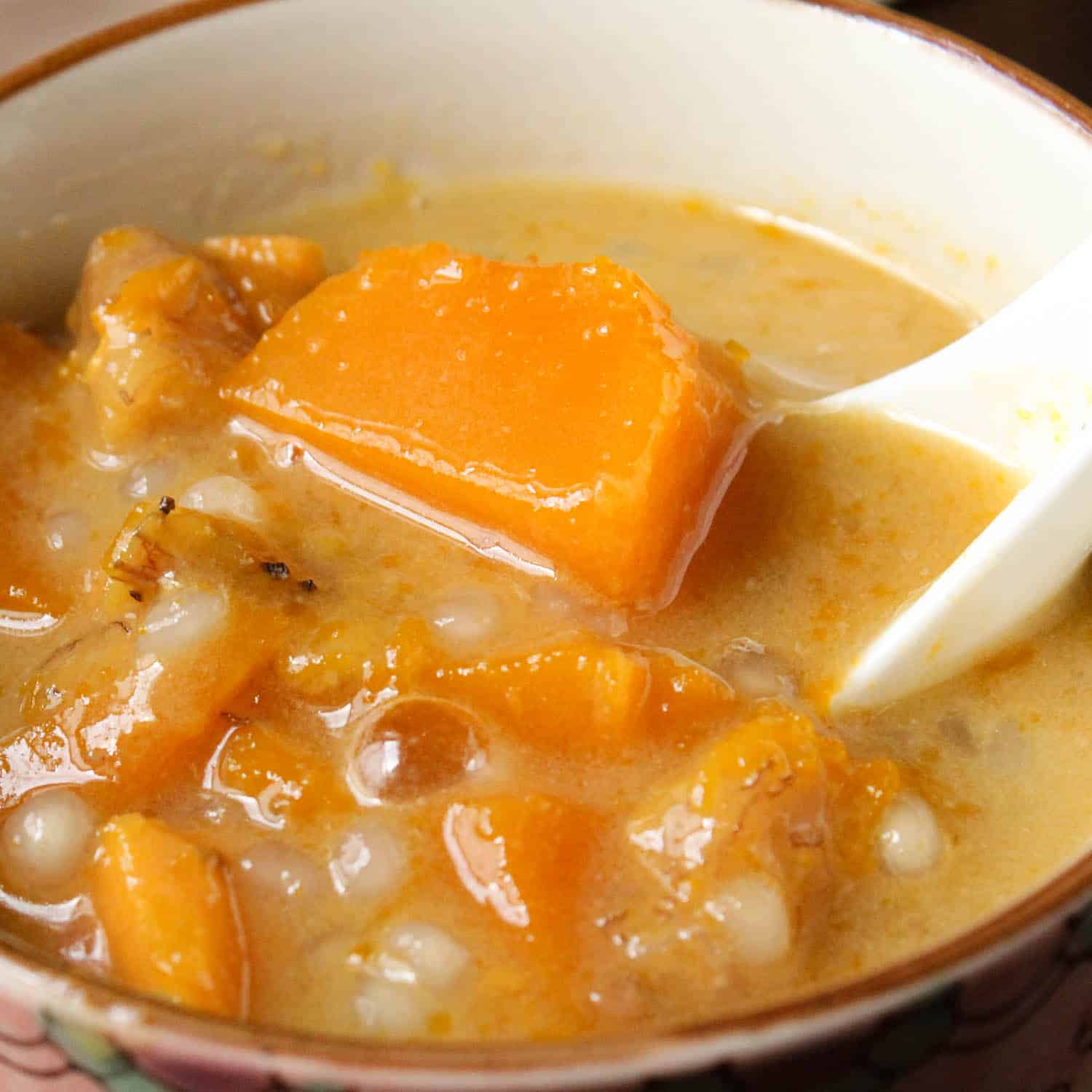
Table of Contents
Kolak Labu Kuning is a popular dessert served during the Iftar meal during Ramadan, where it is traditionally served either room temperature or chilled.
Indonesian food may be unfamiliar to you, but it has many similarities with both Thai food and Malaysian food. In fact, you can find a simplied Thai version of this same dessert here with this Thai Pumpkin Dessert.
Before we get to the recipe, here are some other delicious Veggie Based Desserts (some also being 100% plant based desserts) you might also like to try!
Veggie Desserts
- Pain Patate – Haitian Sweet Potato Pudding
- Thai Stewed Pumpkin
- Sweet Potato Cheesecake Pie
- Yuca Cake Hondurena
History Time 📖
While many people know about Thailand due to the popularity of Thai food in the west, Indonesian cuisine and culture is not as popular. I grew up with Indonesian cuisine and culture because my family is from Suriname. Since both Suriname and Indonesia were both colonized by the Dutch, there is a lot of Indonesian influence on the multi cultural cuisine of Suriname.
In the 1800′;s after slavery ended, many Indonesians were brought to Suriname as indentured servants and they form a vibrant part of Surinamese society.
Indonesia’s rich culinary heritage is a reflection of its diverse history and geography. As an archipelago of over 17,000 islands, Indonesia has been influenced by various cultures over centuries. In addition to Chinese and Indian influence, there is also a lot of Arab influence as Indonesia has the largest Muslim population in the world.
The colonizing Dutch has also influenced the cuisine – one of the reasons you’ll find cheese in many recipes.
Traders came from these countries who brought spices, ingredients, and cooking techniques. The spice trade, particularly in nutmeg, cloves, and pepper, played a significant role in shaping Indonesian cuisine, giving it its signature bold flavors and aromatic spice blends.
The country’s abundant tropical ingredients like coconut, rice, plantain and breadfruit and a variety of fruits and vegetables form the base of many traditional dishes. Kecap Manis, a molasses like sweet soy sauce,, also permeates the cuisine.
Just like Thai food, Indonesian cuisine balances the dance between sweet, sour, salty, and spicy flavors, creating a harmonious blend in every bite. Desserts featuring local vegetables and fruit like Kolak are popular across the islands.
Variations of this dessert can also be found in neighboring countries like Thailand and Malaysia, showcasing the shared culinary influences across Southeast Asia. These countries share a history of trade and cultural exchange, leading to overlapping flavors and cooking techniques.
What is Pandan?
Also known as the vanilla extract of Southeast Asia, pandan leaves come from the leaves of the Screwpine tree. This is the basic flavoring agent used in desserts of the region. This is what gives many of their desserts their characteristic green hue.
Pandan can be utilized in many different form in the desserts of Southeast Asia.
- the whole leaves are often added to infuse a subtle flavor
- the leaves can be blended with water and then strained to produce a pandan extract
- store bought pandan extract
- store bought pandan paste
- dried pandan leaves can be purchased and then reconstituted in hot water

Specialty Ingredient Notes
- Pandan Leaves – Pandan are the leaves of the screwpine tree and have a taste and flavor very similar to vanilla extract. They are the flavoring of choice for most desserts throughout Southeast Asia and even in South Asia where iit is known as kewra water and often used to flavor Indian desserts like kheer or payasam.
- Sweet Potatoes – Although I used the more commonly available orange fleshed sweet potato we have in the U.S. In Indonesia, using batata (purple skinned white fleshed sweet potato) or purple sweet potato would be more common.
Recipe FAQ
Is sago the same as tapioca?
Many people use sago and tapioca interchangeably, but they are not the same. They come from two different plants. Tapioca is processed from the cassava tree, also known as yuca. Sago is processed from a variety of palm tree.
Although they come from two totally different plants, they react the same in cooking so can be substituted for each other. The only difference is that tapioca will require a little more cooking for it to become soft.
What other fruits or vegetables can I use?
Cassava, jackfruit, banana.
What if I can’t find pandan leaves?
Pandan leaves are usually sold in the frozen section at Asian markets. If you cannot source them, you can substitute pandan leaves with pandan essence or pandan extract and as a last resort, you can just add a teaspoon of vanilla extract.
Expert Tips
- If you are substituting tapioca for the sago, you will need to soak your tapiioca for at least 30 minutes as they are firmer than sago. You can even soak it overnight if you’d like.
- The consistency will still be thin after cooking. Be careful not to overcook the kolak because as it chills in the regrigerator, it will thicken quite a bit.
- Other starchy fruits and vegetables like jackfruit, cassava, purple sweet potatoes and banana can also be used.
- If you cannot source pandan leavesm use vanilla beans or vanilla extract.
- Be sure to use canned coconut milk. Do not use tetra pack coconut milk as it is too thin and you will not have the same results.
To learn more about the differences between the types of coconut milk, read all about it here – Types of Coconut Milk.
Ingredients
- sago – Using sago or tapioca will thicken this dessert soup so that after it chills, it will have more of a pudding consistency. It also adds body and texture.
- pandan leaves – Pandan also known as pandanus leaf or screwpine leaves or bai toey in Asian markets is basically the vanilla extract of Southeast Asia as most desserts are flavored with this. You can substitute vanilla extract if you cannot source pandan leaves, pandan extract or pandan essence.
- palm sugar – Palm sugar has smokey caramel notes and you can find it at most Asian markets. You can substitute brown sugar.
- pumpkin (labu) – Pumpkin is a naturally sweet vegetable so perfect in this dessert soup.
- riple plantain (pisang raja) – You want your plantain to be sweet and ripe but still firm enough to have some ttexture. You should look for yellow plantain where the skin has already started to turn black.
- sweet potato (ubi jalar) – Although I used orange fleshed sweet potato, you can also use other varietites of sweet potato like purple sweet potato (ube) or batata.
- coconut milk – Thick coconut milk adds both flavor and body so that the soup will thicken quickly.
How to Make Indonesian Kolak Labu
- Soak sago for at least 20 minutes or overnight.
- In a large pot, bring 6 cups of water to a boil with the pandan leaf and the palm sugar.
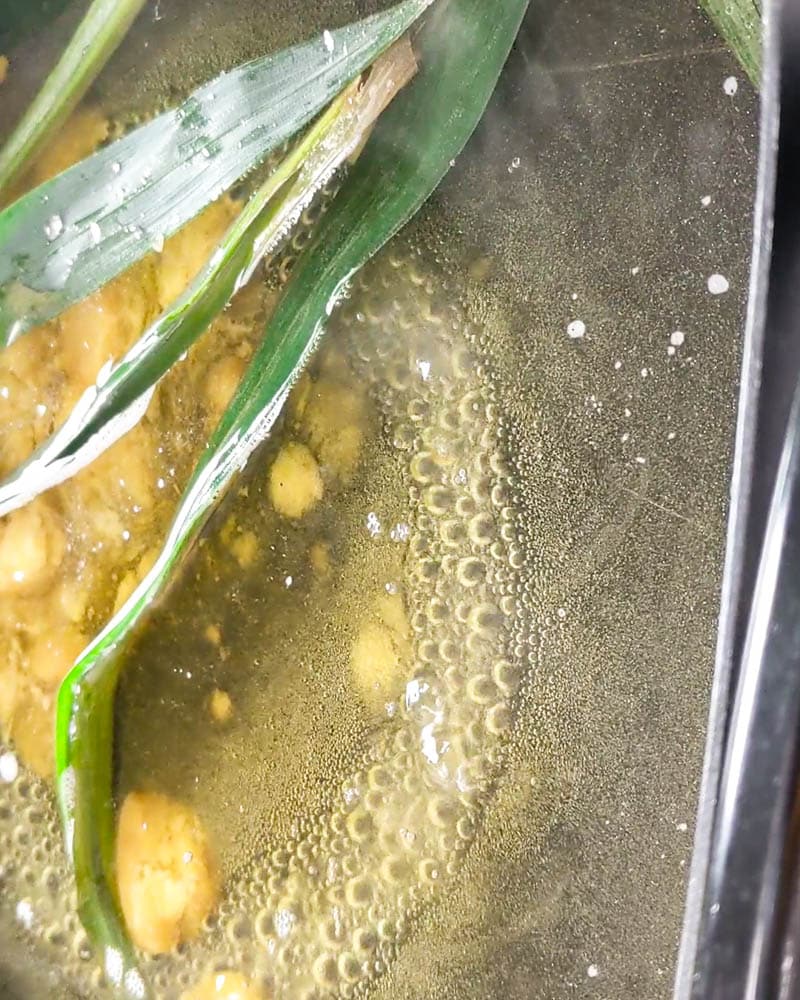
- Once boiling, add the vegetables and let them cook for about 15 minutes.
- Add the sago and coconut milk and simmer for another 15 minutes.
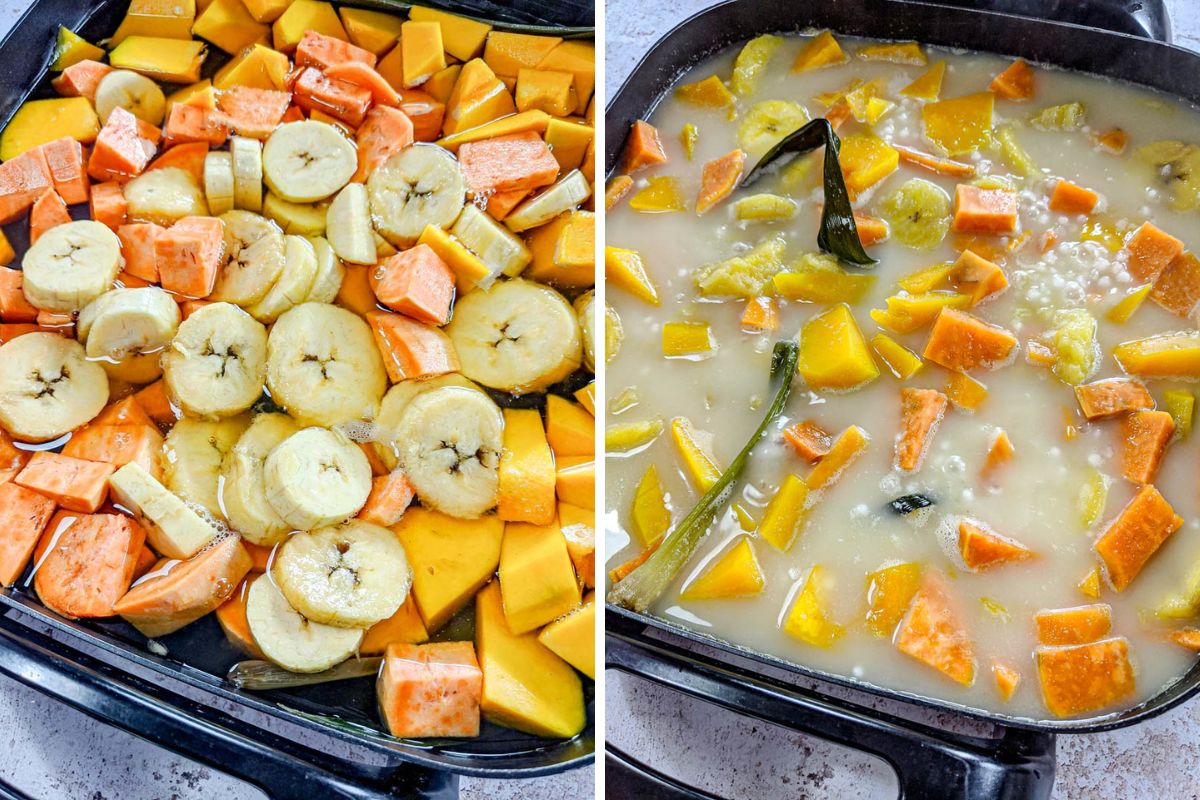
- Discard the pandanus leaf and transfer the kolak to the fridge for at least a few hours so that it can thicken a bit more.
- Serve chilled, warm or at room temperature.
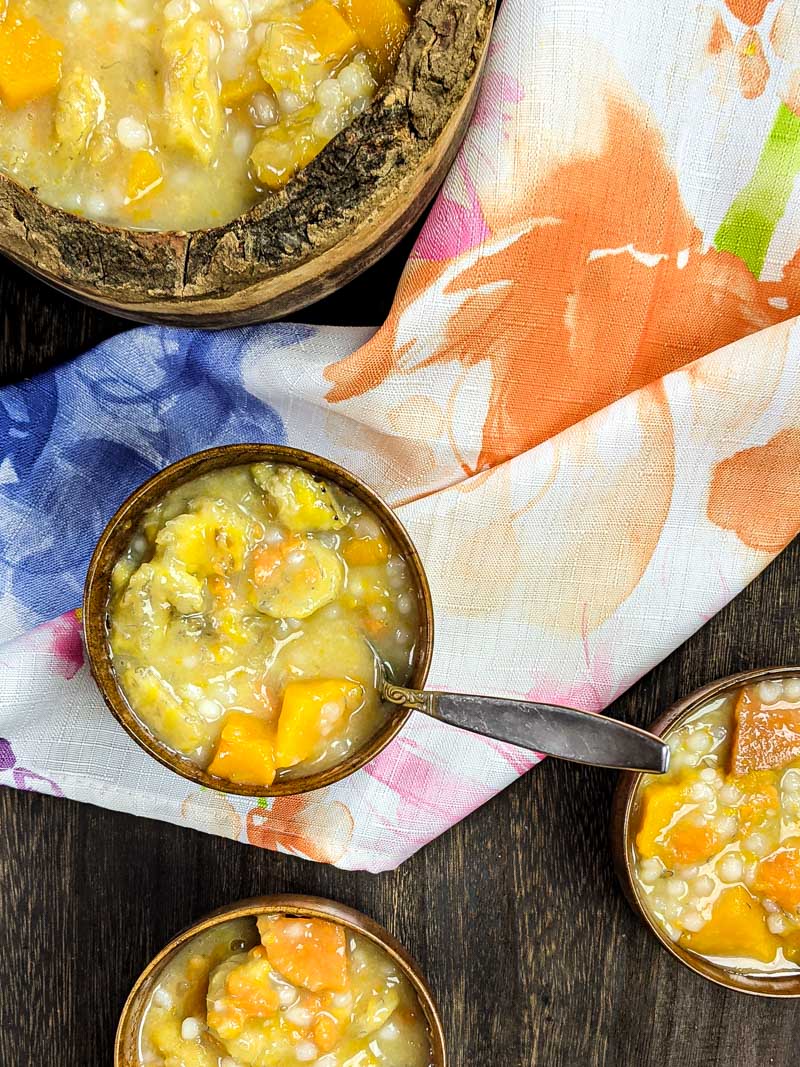
If you’ve been inspired by this delicious recipe, check out some other Indonesian recipes!
Indonesian Recipes

Kolak – Indonesian Dessert Soup
Ingredients
- 1/2 cup sago or tapioca pearls
- 3 pandan leaves or pandan essence
- 1/2 cup palm sugar
- 1 lb. ripe plantain
- 1 lb. pumpkin calabaza or kabocha
- 1 lb. sweet potato
- 3/4 cup coconut milk
Instructions
- Soak sago in water for 20 minutes. Drain.
- In a large pot combine 6 cups water with pandan leaves and sugar. Bring to a boil.
- Add plantain and pumpkin and simmer for 15 minutes.
- Remove pandan leaves. Add sweet potato, sago and coconut milk.
- Simmer for another 15 minutes.
Video
Notes
- Banana, Cassava and Jackfruit can also be used instead.
- Don’t overcook beyond the time specified as it thickens a lot as it chills.
Nutrition
Kuih Dadar – Bujang Dalam Selimut – Asian Stuffed Pandan Crepes for #BreadBakers
Indonesian Cibinong Laksa – Protein Packed Noodle Soup
Suriname Style Javanese Rose Dawet
DO YOU YUM? SAVE IT BELOW!
YumDon’t forget to visit the RECIPE INDEX with over 1000 recipes from around the world including lots of Vegetarian Recipes and Gluten Free Recipes!

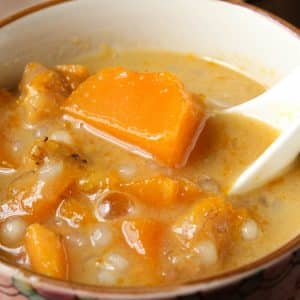
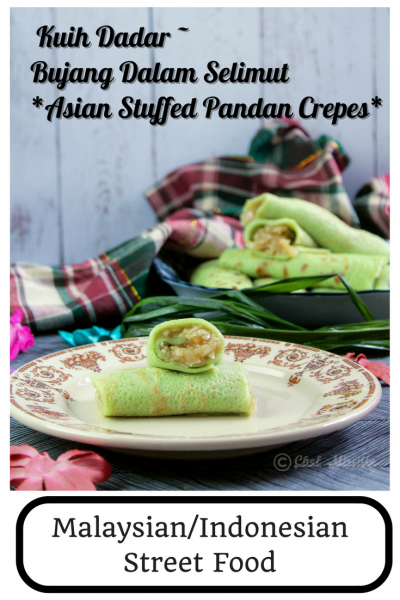
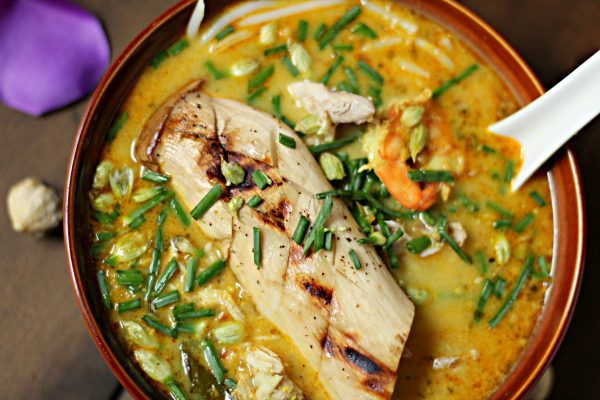



This is a very interesting dessert soup . At first glance I thought mango is dunked in , looks gorgeous and come to think of it , it is so nutritious .
Amazing pick !
so nutritious and filling 🙂 loved the flavours here
Wow desert soup sounds interesting. Love the flavors.
That’s a fantastic remake of a sweet dish, the ingredients seem too good to combine..as you know in Indian cuisine, we make anything as a halwa, making it as a liquid sweet is a new thing for me..very interesting!
dessert soups in more in Southeast Asia and Central Asia but I think you would enjoy it!
The concept of a dessert soup is something new to me. Looks interesting.
its very common in Central Asia and Southeast Asia.
I know this is common in central Asia will love to try it soon. But since I don’t get pandan leaves will find a way around.
dont let the lack of pandan stop you. Just add a few teaspoons of vanilla extract instead
woow!!Dessert soup!!Looks very delicious!!
thanks – it truly is
Its always a delight to read about different cuisines on your blog. A unique share for the theme.
thanks I try!
Sounds like our kheer but that is a nice twist adding veggies in it. Looks so good..
wont even notice you are eating veggies in this delicious dessert soup
The dessert soup looks super tempting.
I think you would enjoy it!
Wow Mir, dessert soup looks delicious, more kind of our kheer, but with whole veggies, i m sure this must be tasting good.
BTW, I happened to taste Dodol in Malaysia, but couldn’t get that puteri ayu mould !enjoyed tasting the local vegetarian cuisine!
it must be challenging for the veg cuisine there. awww too bad you couldnt find the mold 🙁
Hmm dessert soup.. Thats so unique and as others pointed out its like our payasam. 🙂 I love pumpkin payasam and am very much interested to try this as well.. This makes me realize again how much world cuisine is connected.
It is so true. Many recipes cross countries and cultures, albeit with slight variations.
Absolutely delicious – this was my first time making a dessert soup and I absolutely love the flavours!
Looks delicious! I’d love to try this one with my family.
It’s definitely a healthy dessert option for your family!
Dessert soup- I love the idea of this lighter dessert for this weather. This sounds so refreshing and love that you gave us customization options!
Yes you can totally customize it to ingredients that are locally available for you.
What a delicious dessert soup! I love the concept of adding vegetables to a dessert, it was a new concept for me, and I appreciate being introduced to this!
yes this makes it a healthy yet uber delicious dessert!
I’ve never tried a dessert soup before. It looks really tasty. Will definitely be giving this a go soon!
This can be eaten warm or cool, which means this dessert soup is great for any season. I am sure you will love it!